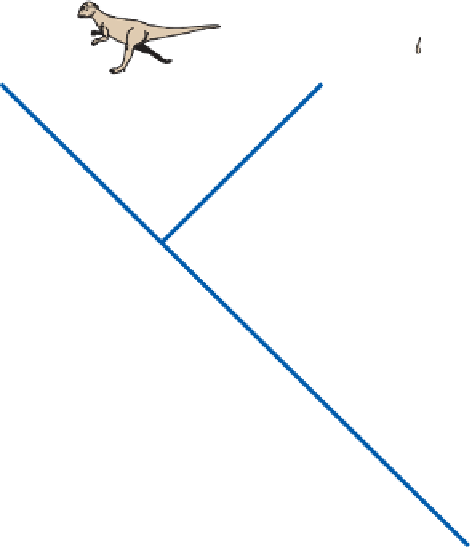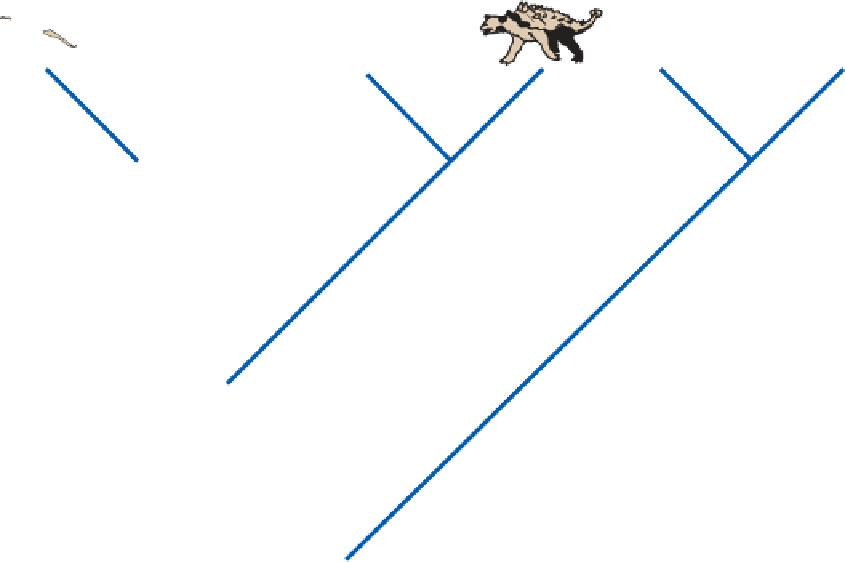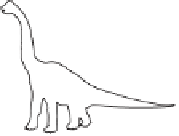Geology Reference
In-Depth Information
Pachycephalosaur
Ankylosaur
Theropod
Sauropod
Ceratopsia
Stegosaur
Ornithopod
Ornithischia
Saurischia
Ilium
Ilium
Pubis
Dinosaurs
Ischium
Pubis
Ischium
◗
Figure 22.25
Cladogram Showing Relationships Among Dinosaurs Pelvises of ornithischian and
saurischian dinosaurs are shown for comparison. All the dinosaurs shown here were herbivores,
except for theropods. Note that bidpedal and quadrupedal dinosaurs are found in both ornithischians
and saurischians.
such as diminutive
Coelophysis
and medium-sized
Deinony-
chus
probably hunted in packs.
The second group of saurischians, the sauropods, includes
the truly giant, quadrupedal herbivorous dinosaurs such as
Apa-
tosaurus
,
Diplodocus
, and
Brachiosaurus
, the largest land animals
ever (Table 22.1).
Brachiosaurus
, a giant even by sauropod stan-
dards, may have weighed 75 metric tons, and partial remains
from several areas indicate that even larger sauropods may have
existed. Trackways show that sauropods moved in herds.
Sauropods were preceded in the fossil record by the
smaller Late Triassic to Early Jurassic
prosauropods
, which
were undoubtedly related to sauropods, but were probably
not their ancestors. Sauropods were most common during
the Jurassic; only a few genera existed during the Cretaceous.
Scientists recognize fi ve groups of ornithischian dino-
saurs: ornithopods, pachycephalosaurs, ankylosaurs, stego-
saurs, and ceratopsians (Table 22.1). Ornithopods consist of
several subgroups, including the familiar duck-billed dino-
saurs or hadrosaurs. Hadrosaurs were especially numerous
during the Cretaceous, and several species had head crests
that may have been used to amplify bellowing, for sexual dis-
play, or for species recognition (see Geo-inSight on pages 618
and 619). All ornithopods were herbivorous and primarily
bipedal, but they had well-developed front limbs that allowed
them to walk in a quadrupedal manner, too.
The Late Cretaceous ornithopod
Miasaura
(''good
mother dinosaur'') nested in colonies and used the same
nesting area repeatedly where 2-m-diameter nests were
placed 7 m apart or about the length of an adult. Some nests
contain juveniles up to 1 m long, which is much larger than
when they hatched, so they probably stayed in the nest area
where adults protected them and perhaps fed them. The fact
that
Miasaura
lived in vast herds is demonstrated by the fos-
sils of an estimated 10,000 individuals in a single bone bed
in Montana. Apparently, they were overcome by toxic gases
from a volcano and later buried in fl ood deposits.
The most distinctive feature of the pachycephalosaurs is
their thick-boned, dome-shaped skull (Table 22.1). However,
the traditional view of these as animals that butted heads
for dominance or mates has been challenged. Now some





















































Search WWH ::

Custom Search